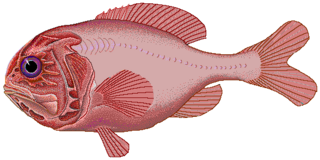
Slimeheads, also known as roughies and redfish, are mostly small, exceptionally long-lived, deep-sea beryciform fish constituting the family Trachichthyidae. Found in temperate to tropical waters of the Atlantic, Indian, and Pacific Oceans, the family comprises about 50 species in eight genera. Slimeheads are named for the network of muciferous canals riddling their heads.

Ridgeheads, also known as bigscales, are a family of small, deep-sea stephanoberyciform fish. The family contains approximately 37 species in five genera; their distribution is worldwide, but ridgeheads are absent from the Arctic Ocean and Mediterranean Sea. Although the family is one of the most widespread and plentiful of deep-sea families, none of its members are of interest to commercial fishery.

The stream catfishes comprise the family Akysidae of catfishes.
This glossary of ichthyology is a list of definitions of terms and concepts used in ichthyology, the study of fishes.

The Banggai cardinalfish is a small tropical cardinalfish in the family Apogonidae. It is the only member of its genus. This attractive fish is popular in the aquarium trade. It is among the relatively few marine fish to have been bred regularly in captivity, but significant numbers are still captured in the wild and it is now an endangered species. The detrimental impact of humans on its environment and certain fatal diseases threaten this species' numbers significantly. Iridovirus diseases are known to be significant reason for fish mortality.

Mycteroperca is a genus of marine ray-finned fish, groupers from the subfamily Epinephelinae, part of the family Serranidae, which also includes the anthias and sea basses. They are predatory fish, largely associated with reefs and are found in tropical and subtropical seas in the Atlantic Ocean and the eastern Pacific Ocean. They are important target species for fisheries.

Apogon imberbis, the cardinalfish, the Mediterranean cardinalfish or king of the mullets, is a species of ray-finned fish, a cardinalfish belonging to the family Apogonidae. It is widely distributed in the Mediterranean and along the warm temperate and tropical eastern Atlantic coasts from Portugal south to the Gulf of Guinea.

The belted cardinalfish is a tropical marine fish in the genus Apogon. They grow up to 6.5 centimetres (2.6 in) in length. Belted cardinalfish are found in the waters of the western Atlantic Ocean, off Central and South America, inhabiting caves and holes. They are pinkish-red on the dorsal side and yellowish-red on the ventral side. Their eggs are carried in the mouth of the adult as they mature.

The Indian threadfin is a species of marine ray-finned fish from the family Polynemidae, the threadfins. It is a coastal species from south-east Asia which has been recorded in Papua New Guinea.

The redmouth grouper, also known as the red-flushed rock cod is a species of ray-finned fish, a grouper from the subfamily Epinephelinae which is part of the family Serranidae, which also includes the anthias and sea basses. It has a wide distribution in the Indian and Pacific Oceans. It is considered a game fish.
The Gladius sea chub is a species of marine ray-finned fish, a sea chub in the family Kyphosidae. It was recognised a new species in 2013 and is found in the southeastern Indian Ocean where endemic to the southern coasts of Western Australia.

Paroncheilus affinis, the bigtooth cardinalfish or longtooth cardinalfish, is a species of marine fish in the family Apogonidae and the only member of its genus. The bigtooth cardinalfish lives in the west-central Atlantic, off southern Florida, United States, and from the Bahamas to Venezuela, and as far south as Suriname. This species also is found in the east-central Atlantic and the Gulf of Guinea, and has been reported as far as Cape Verde. It is a pale orangeish colour.

Polydactylus sextarius, the blackspot threadfin, is a species of marine ray-finned fish, a threadfin from the family Polynemidae which is native to the western Pacific and eastern Indian Oceans.
The dwarf paradise fish, also known as the streamer threadfin or streamered tasselfish, is a species of ray-finned fish from a family Polynemidae, the threadfins. It is the only species in the genus Parapolynemus and it is found in Australia and New Guinea.

Jaydia queketti, the spotfin cardinal or signal cardinalfish, is a species of ray-finned fish from the Indian Ocean, it is a member of the family Apogonidae. It has colonised the eastern Mediterranean Sea by way of the Suez Canal since 2004.

Jaydia smithi, Smith's cardinalfish, is a species of ray-finned fish from the Indian and Pacific Oceans, a member of the family Apogonidae. It has colonised the eastern Mediterranean Sea by way of the Suez Canal since 2007.

Cheilodipterus novemstriatus, the Indian Ocean twospot cardinalfish, is a species of ray-finned fish from the Indian Ocean, which is a member of the family Apogonidae. It has colonised the eastern Mediterranean Sea by way of the Suez Canal since 2011.
Apogonichthyoides pharaonis, the Pharaoh cardinalfish, is a species of cardinalfish from the family Apogonidae which is found the western Indian Ocean and Red Sea. It is one of a group of species which have colonised the eastern Mediterranean Sea from the Red Sea via the Suez Canal, a process known as Lessepsian migration.

Kyphosus bigibbus, the brown chub, grey drummer, darkfin drummer, insular rudderfish, grey chub, grey sea chub, southern drummer or topsail drummer is a species of marine ray-finned fish, a sea chub from the family Kyphosidae. It is a herbivorous species which is found in subtropical and tropical seas worldwide.

The paradise threadfin is a species of catadromous ray-finned fish, a threadfin from the family Polynemidae which is found in south and southeast Asia in freshwater rivers where it is a valued food fish.














